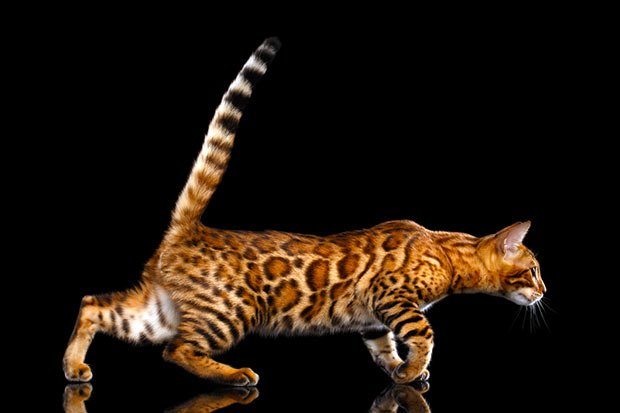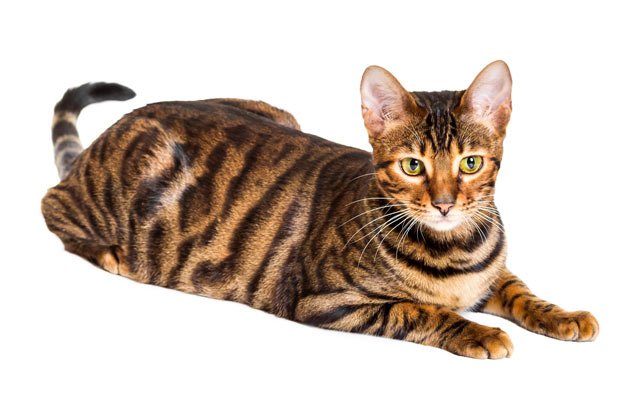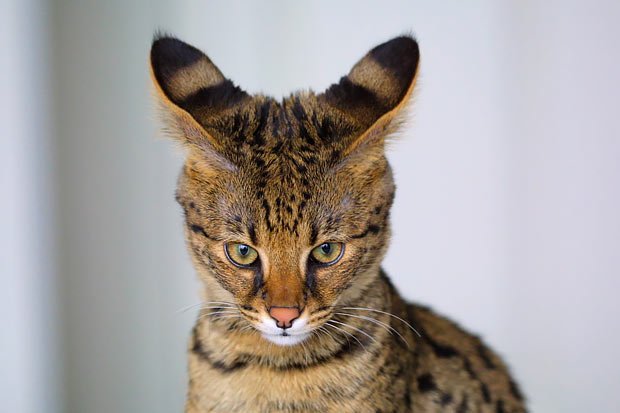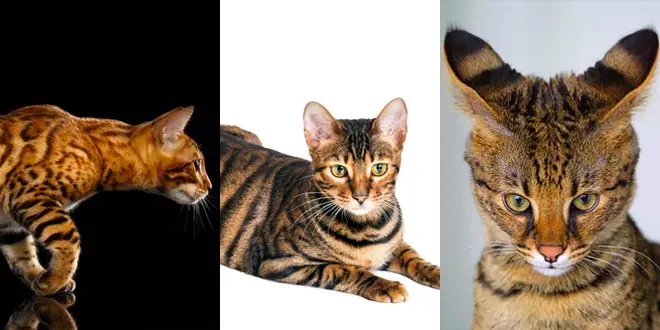[ads1][dropcap]T[/dropcap]he awe-inspiring beauty of big cats of the wild has been fascinating humans for hundreds of years. The combination of their strong constitution and predatory nature, however, made it hard for people to admire them up close. This all changed when a few people with visionary ideas and a penchant for breeding decided it’s time to make a domestic cat with all of the gorgeous, exotic looks of the wildcats, but with none of their dangerous habits.
These miniature versions of the spotted and striped predators of the jungles and savannas are now cherished family pets, with lovable personalities and unique traits. But, how did Bengals, Toygers, and Savannah cats came to be in the first place? What is the story behind these extraordinary hybrid cat breeds? Read on to find out more!

Creating A Cat Breed
Apart from cat breeds that have been around for a couple of centuries, such as Siamese, Persian cat or Turkish Angora, most of the felines with a pedigree that are extremely popular nowadays have been bred in the last 50 years. Even the breeds considered to be “ancient” are continuously being perfected by breeders around the world, who strive to be the ones to create an ideal representative of the breed. But how does one create a breed? What does it take to create a cat that looks and acts a certain way?
When it comes to the development of a new breed, the key is to breed selectively. Artificial selection or selective breeding, as it’s more often referred to, is the process in which humans intentionally breed animals with desirable traits and features, in an attempt to selectively develop a set of characteristics (phenotypic traits) through their offspring. In the world of feline breeding, a new breed can be a product of:
[tie_list type=”checklist”]
- Crossbreeding domestic cat breeds
- Propagating a rare body-type genetic mutation
- Hybridization between wildcats and domestic cat
[/tie_list]
Breeds such as Toyger or Bombay are a product of crossing two different breeds of the domestic cat, with the goal to create a new, distinct breed with a select set of desirable traits from both parents. Felines like Munchkin, Manx or Scottish Fold came into existence thanks to a rare genetic mutation that was isolated in the parents and then propagated through their offspring. And, in the end, exotic cat breeds such as the Bengal, Savannah or Chausie are a result of mating wild and domestic cats, in order to create felines with exotic jungle looks and mild, docile temperament.
However, it’s extremely important to note that the wild genes of these breeds are reserved for the first three generations of the breed only. These foundation cats are called EG (Early Generation). The later generations keep the distinct looks, but their wildcat relatives become distant ancestors, so the breed developed through hybridization is to be considered a fully domestic breed. For more about filial generations and how to choose the right generation of a hybrid breed, make sure to take a look at the first step of the article 9 Steps To Buying A Healthy Bengal Kitten.
However, bringing the first generation of a new breed to the world doesn’t mean that you’ve established a cat breed. After the first generation is born, it’s necessary to continue selective breeding between fertile cats to create a breed standard, and ensure the most important thing of all- that the offspring carries healthy genes and that the breed doesn’t have any inheritable health problems.
This is the process behind the development of any cat breed. It all starts with an idea, that evolves through generations, until there is a set of distinct characteristics considered to be a standard. Here are the stories of how the three most popular exotic cat breeds were developed- from first litter to the cats we know and cherish today!
Bengal Cat

In the late 1970s, Dr.Willard Centerwall probably had no idea that his research on leukemia is going to result in a new cat breed. The comparative gene mapping of cats and humans he did for his research of leukemia was the reason the director of the genetics, birth defects and chromosome services at the Loma Linda University Medical Center was the first person to breed a domestic cat to an Asian Leopard cat, resulting in the first litter of hybrid kittens that would later become the beloved Bengals.
After finishing his study, Dr. Centerwall was left with a few F1 Bengal kittens he had to put up for adoption. He met Jean Sugden Mill through a mutual friend, and, as they say, the rest is history. A feline enthusiast with interest in genetics, Mill leaped at the chance to create a new breed she envisioned as “living room leopards”, cats that would retain the wild looks of their ancestors but have a mild, lovable character that would make them suitable to be family pets. She started developing the breed in the 1980s, and her fierce-looking, unique Bengal cats quickly garnered a lot of attention in the media.
[ads2]
It was the media’s attention who, in a way, helped Bengal cats become the breed they are today, as one of the people who helped the development of this breed the most, Anthony Hutcherson, learned about Bengals through Cat Fancy, a magazine dedicated to felines. When he was a young boy, he saw a photo of Jean Sugden Mill with her Bengal cats and instantly fell in love. As a kid who was fascinated by wild cats and always dreamed of having an Ocelot as a pet, it’s no surprise he found Mill’s spotted, leopard-like felines mesmerizing. A few years later, he got in touch with the original breeder of Bengals, and decided to start a Bengal cat breeding program on his own.
In his own words, Anthony Hutcherson best describes how an established feline breed is developed:
“It’s like any good chef will probably tell you. It’s not adding a bunch of different stuff into a soup. It’s what you choose to add, and how much, and when you add it”
His own vision of the ideal Bengal cat, the one he shared with Mill, was so specific and clearly defined that he could easily recognize even the most peculiar traits of parents he wanted to transfer to the offspring. From prominent rosettes, trademark glitter coat to big cat gait, each detail is important for a passionate breeder. But even breeders like Anthony, whose Bengal cats are frequently shown and awarded, think that they still haven’t reached that ideal breed standard. They are always working on improving the quality of the gene pool, perfecting the standard and creating truly stunning Bengal cats with extraordinary features.
Toyger Cat

A striped exemption amongst spotted hybrid felines, the Toyger is a breed developed by Judy Sugden, the daughter of Jean Sugden Mill, the creator of the Bengals. Not long after her mother started developing the leopard-like felines, Jean embarked on a breeding quest of her own. However, her vision of a striped, reddish cat that would resemble a real tiger couldn’t be a result of crossbreeding between a wild cat and a domestic cat, so she had to find domestic cats with distinct traits and breed them selectively. Sugden started with breeding her mother’s Bengal cats who didn’t display the desirable rosettes and domestic cats with prominent stripes. The fact she couldn’t access the wild genes needed for the authentic looks, like her mother did, only made Judy’s job much harder. Her need for selective breeding was even bigger than it was with Bengal cats.
Her extraordinary story of developing the Toygers we know today includes even importing a street cat from India who displayed tiger-like features. The road to the green-eyed, striped cats with reddish fur definitely wasn’t an easy one. As a breed younger than the Bengals, the Toygers can still be considered as a breed in development. Judy herself thinks there’s more room to perfect the breed, making these domestic cats look like tigers as possible. After all, her initial goal was to create a toy tiger, and her keen eye and perfectionism help her recognize which traits should be more emphasized in order to achieve the ideal standard.
Savannah Cat

Best known as the largest domestic cat breed. Savannahs are a product of crossbreeding between an African Serval, a small wild cat, and a domestic cat. In 1986, a Bengal breeder named Judee Frank bred a Serval with a domestic cat, which resulted in one kitten she named Savannah, which is how the breed got its name. A few years later, Patrick Kelly and Joyce Sroufe decided to develop a breed inspired by the gorgeous Savannah kitten who stole their hearts.
These majestic cats can weigh up to 30 pounds and stand as tall as some medium-sized dogs, which, when combined with their wild looks, makes these cats look quite impressive. Their unique looks are achieved by combining the traits of the Serval and specific domestic breeds, Ocicat, the Oriental shorthair, the Egyptian Mau and the domestic shorthaired cat. Even though it’s hard to develop any breed through selective breeding to satisfy a certain standard, for Savannahs, the matters are even more complicated.
[ads2]
Namely, it’s extremely hard to obtain a first generation Savannah cat. The reason for this is that Servals have a longer gestation period than domestic cats, which often results in problems and complications with the pregnancies, and they are incredibly picky when it comes to choosing their mates, so they often don’t want to breed with domestic cats at the first place. This means that, even before the hard work on perfecting the breed standards begins, the Savannah breeders are faced with difficulties in producing F1 kittens.
Considering the complicated process of creating the Savannah cat, and their particularly exotic looks, it’s no wonder the price for a Savannah kitten can go up to $20,000. But, even though they are undoubtedly stunning, these cats are still in the earlier stages of breed development. Unlike Bengal cats, these felines are still a work in progress, and their closeness to their wild ancestors is a reason they are illegal to own in quite a few states in the U.S.
Significance of Responsible Breeding
Due to the rise in numbers of backyard breeders, who, because of their own greed, produce great numbers of cats raised in appalling conditions, reputable breeders have been stigmatized as well. Regardless of one’s position on breeding, it’s really important to make the distinction between these two types of breeders. Apart from treating animals inhumanely and bringing sick or inbred kittens to the world, backyard breeders do nothing to improve the breed’s standards.
Reputable breeders treat their cats with utmost care, choosing some cats to further the breed’s development by selective breeding, and selling others as pets to the right families for them. Every kitten from a responsible breeder is required to come back to his breeder should the owner no longer be able to provide a standard of care. People like Anthony Hutcherson, Jean Sugden Mill or Judy Sugden amongst many others are the reason we get to enjoy the one-of-a-kind, miniature wildcats of today. Their passion and efforts led them to follow their dreams of toy tigers, living room leopards and Ocelot replicas, and create breeds that have so much more to offer than their marvelous looks.
Make sure to check out the article from Ezra Klein that was the inspiration for this article: “Meet the designer cats with wild blood” on Vox website!




